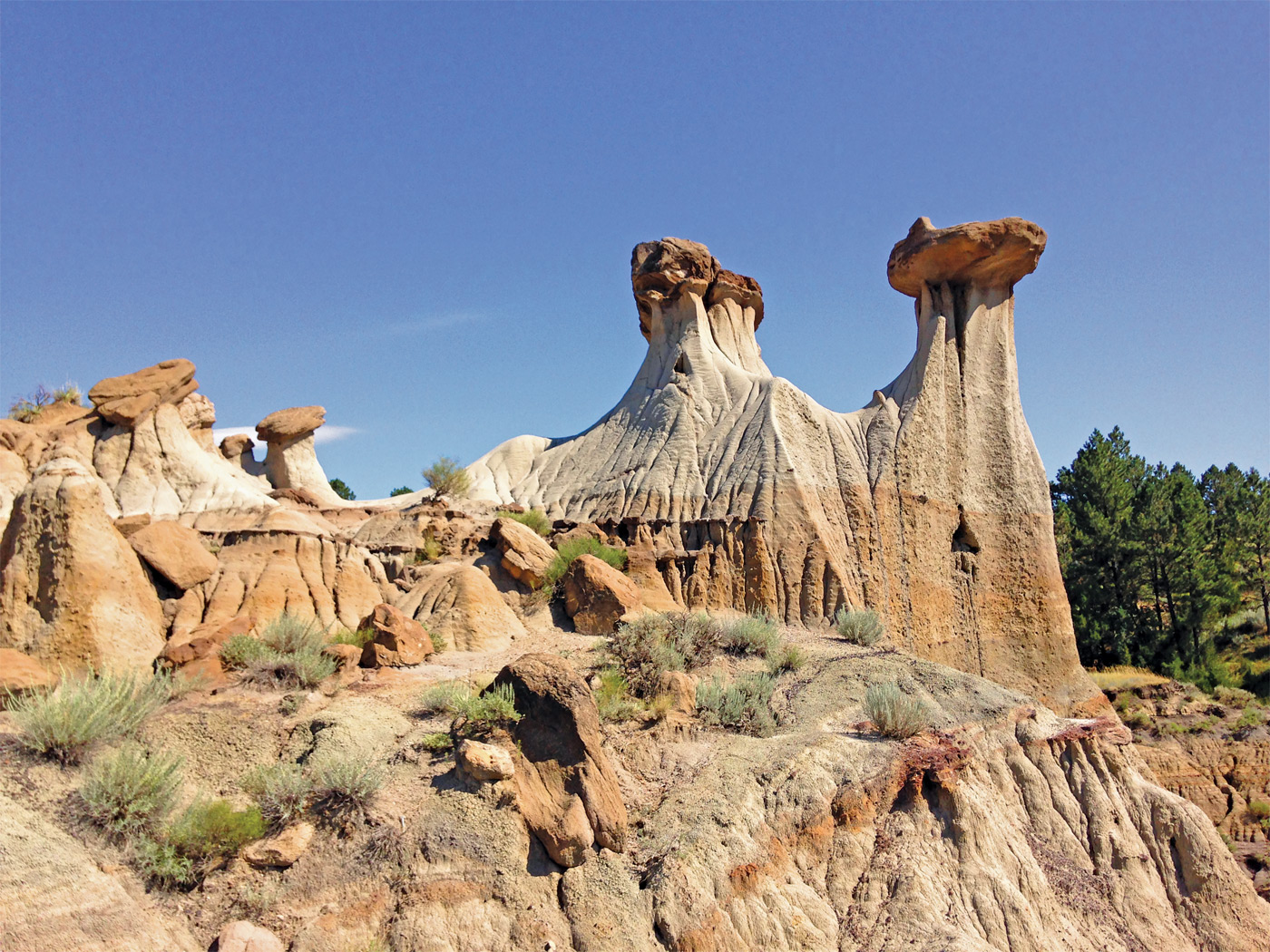Evolutionary scientists found evidence that the Sahara Desert was green and fertile at the end of the Ice Age, allowing people to live hundreds of miles west of the Nile River.1 These findings corroborate creationist predictions of an extended wet period after the Flood.2
A global collaboration of scientists, led by Abdallah Zaki of the University of Geneva, Switzerland, reconstructed the ancient drainage patterns of five Nile River tributaries and another small river that drained into what is now Lake Nasser.3 Today, the six rivers are sinuous ridges of pebbles and cobbles that extend across nearly 15,000 square miles of southern Egypt and northern Sudan.1
The team of geologists started with measuring pebble sizes on the six dry riverbeds. Larger pebbles equate to higher waterflow velocities. Secondly, the team determined the surface areas for the ancient river drainage basins by mapping the topographic divides between each river. Drainage basins are like a collection bowl that gathers rainwater for the streams.
Using these two calculations, the scientists estimated the precipitation rates that transported the various pebble sizes in each river.4 They concluded that a major episode of high river activity occurred during the latter part of the Ice Age, known as the African Humid Period (AHP), and into the years afterward.
Of course, secular scientists claim the AHP was between 14,800 and 5500 years ago, but creation scientists dispute these great dates. Instead, we think the real dates for the AHP should be placed immediately after the Flood, possibly about 4500 to 3500 years ago, coinciding with the post-Flood Ice Age.2 In further support of these younger dates, a stele found in Karnak temple mentions catastrophic storms and flooding of the Thebes region (150 miles north of this study) that occurred 3500 years ago.1
Zaki et al. determined the amount of rainfall was much higher during the AHP.1 Lead author Abdallah Zaki said, “We found that our paleohydraulic estimates indicated rainfall intensities in the range of 55-80 millimeters [2.16-3.13 in] per hour-that’s 3-4 times more than before and after the African Humid Period.”4 Zaki et al. calculated that mean annual rainfall during the AHP was in the range of 11.8-36.2 inches per year, providing ample water to support a savannah and grasslands in the eastern Sahara during this time.1 The Sahara wasn’t a dry arid place after the Flood. It was well watered for a considerable length of time, likely for more than 1000 years after the Flood. This evidence fits the biblical account in Genesis perfectly.
Accepting the Flood account as history helps us better explain what Zaki et al. discovered and makes sense of the dry river beds in the eastern Sahara. Flood geologists think the oceans were much warmer at the end of the Flood due to the creation of a completely new seafloor from lava during the Flood year. The heat from the cooling lava caused the ocean water above to rise in temperature as much as 30 degrees Celsius hotter than today.5 This would cause evaporation rates to be as much as 3-7 times today’s rates.5 This high evaporation period, and its resulting rainfall, would probably have lasted for over 1000 years until the oceans cooled to near modern temperatures, shutting down the high rain supply to the Sahara.
These predictions match well with the 3-4 times heavier annual rainfall that Zaki et al. calculated, confirming the biblical explanation for the AHP. It also confirms earlier interpretations/predictions for the post-Flood climate in Egypt:
I doubt if the Egyptians built an empire in the desert like we find there today. At the time of the Patriarchs, this area would have been affected by the Ice Age too, creating a wetter and more humid climate. It wasn’t until centuries after the Ice Age, that the Egyptians began to rely increasingly on the Nile as a source of water as the desertification process took hold and the Earth’s climate found a new equilibrium.6 The book of Genesis is a work of true history from the very beginning. There really was a global Flood. And the new discoveries about the ancient climate in Egypt confirms the predictions of Flood geologists.
References
1. Zaki, A., et al., 2021. Did increased flooding during the African Humid Period force migration of modern humans from the Nile Valley? Quaternary Science Reviews. 272: 107200
2. Clarey, T. 2020. Carved in Stone: Geological Evidence of the Worldwide Flood. Dallas, TX: Institute for Creation Research, 354-377.
3. A tributary is a smaller stream that drains into a larger main trunk river.
4. Makoni, M. The “Green Sahara” left behind fossil rivers. Eos. Posted on eos.org December 10, 2021, accessed December 20, 2021.
5. Oard, M.J. 2004. Frozen in Time: The Woolly Mammoth, the Ice Age, and the Bible. Green Forest, AR: Master Books. 6. Clarey, Carved in Stone, 366-367.
*Dr. Clarey is Research Scientist at the Institute for Creation Research and earned his doctorate in geology from Western Michigan University.
Evidence Supports Post-Flood Wet Climate for Egypt
The Latest
CREATION.LIVE PODCAST
Searching for Truth Across the Globe | Creation.Live Podcast:...
How can we bring the Gospel of Jesus Christ and the truth of creation to others outside our small spheres of influence?
Host...
Marine Mammals: Designed for Deep Diving
While you’re reading this, hold your breath. What is now happening is your blood is delivering the last of oxygenated blood cells to your tissues...
CREATION PODCAST
Humanity's Demise at the Hands of Genetic Entropy | The Creation...
Welcome to the fourth episode in a series called “The Failures of Old Earth Creationism.” Many Christians attempt to fit old earth...
''Inside-Out'' Fossil is Amazingly Preserved
It is widely known that vast numbers of fossils—vertebrate and invertebrate—have been discovered incredibly well-preserved.1,2...
The Resurrection and the Origin of Life
At Easter time we focus on the cardinal Christian doctrine of the Resurrection. Without the Resurrection, Christianity is a sham. The truth that Jesus...
Is an Ancient Extinct Tree-Dweller Our Relative?
Human evolution has always been hazy with seemingly as many attempted explanations for how we evolved from animals as there are paleoanthropologists.
Evolutionists...
The Return of the Dire Wolf?
There’s been much recent excitement about the birth of three dire wolf (Aenocyon dirus) puppies by a Dallas-based biotech company: Colossal Bioscience....
CREATION PODCAST
Cracks in the Layers: Lake Suigetsu and the Old Earth Illusion...
Welcome to the third episode in a series called “The Failures of Old Earth Creationism.” Many Christians attempt to fit old earth...
Fish Fossil Vomit
A rather unsavory news story recently appeared regarding fossilized vomit. Although it’s hardly dinner table conversation, it nonetheless supports...
Dino Footprints Down Under
Dinosaur trackways1 are once again making the news. Australia is the setting of a remarkable series of dinosaur tracks attributed to ornithischian...





















